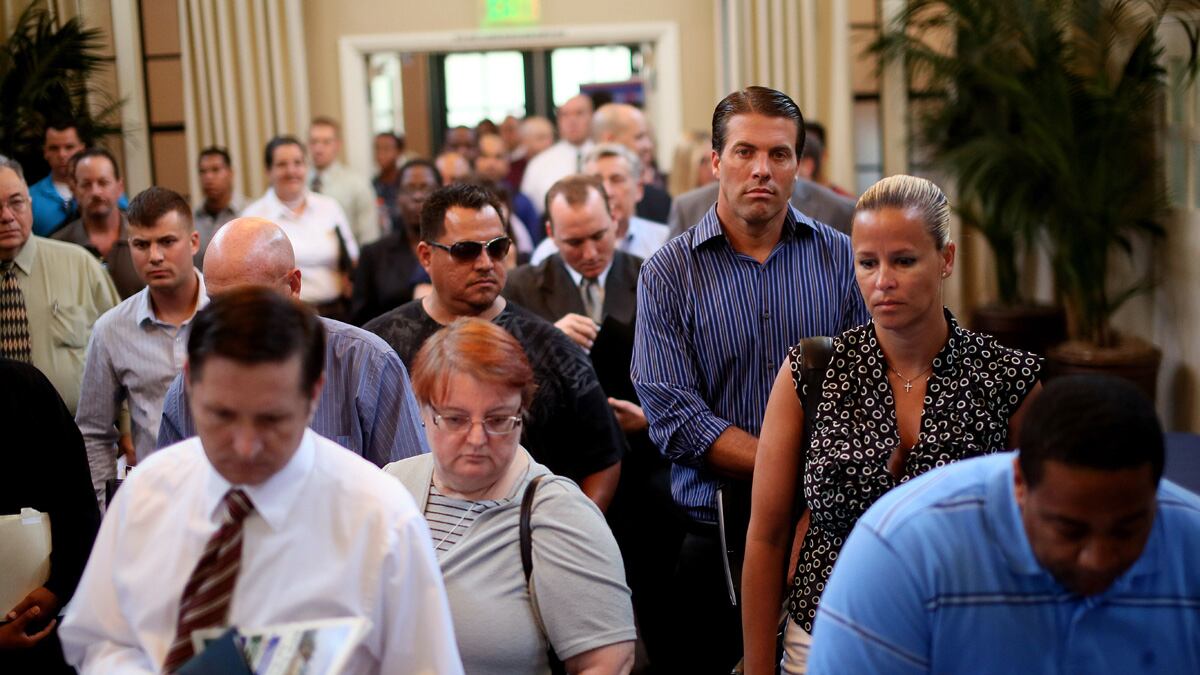So the August employment report was something of an egg drop. Political and economic analysts alike had been gearing up for Friday morning’s report from the Bureau of Labor Statistics. Coming on the heels of President Obama’s speech, and about 60 days before the election, the monthly tally of jobs added and lost could either buttress Obama’s narrative of recovery or strengthen challenger Mitt Romney’s claim of malaise. And anticipation was rising. Earlier in the week, unemployment claims fell and ADP, the payroll-processing company, reported that the private sector added 201,000 jobs in August. Hopes were rising for a satisfying, large number.
The result, however, was a triple-decker Meh sandwich, slathered with Blah.
The good news? The economy did add jobs in August, tacking on 96,000 new positions from July. Compared with a year ago, there are two million more Americans with private-sector payroll jobs. Strength was seen in professional and technical services (27,000 new jobs), health care (17,000 new jobs), and finance and insurance ( 11,000 new jobs), and food services and drinking establishments (27,000 new jobs). Translation: steadily rising consumer and business demand for goods and services is pushing some companies to hire. Manufacturing, which has been a pocket of strength in employment, cut 15,000 jobs. The reported reduction was in large measure a result of a statistical quirk—because car companies didn’t lay off as many workers for summer shutdowns in July as they usually do, they didn’t call as many back to work as they usually do. In BLS-land, that registers as a decline in employment.
The difference between 96,000 and 100,000 jobs is miniscule from a statistical point of view. But it’s pretty significant from a political point of view. A five-figure gain just seems weaker than a six-figure gain. And we can blame U.S.-style austerity for part of August’s weak performance. It’s little known or understood, but for the past few years the U.S. has been engaged in what I call “the conservative recovery.” Every month, the private sector adds jobs, frequently a decent amount. But every month, the government sector—local, state, and federal agencies pinched by austerity—cuts employment. August was no different. During the month, the private sector added 103,000 jobs while the public sector cut 6,000. In the past year, in fact, the government sector has reduced employment by 934,000. The private sector now accounts for 83.6 percent of all U.S. jobs, compared with 83.2 percent a year ago.
But there was plenty of news in this report to indicate that the job-creation engine downshifted in August. The average work week was unchanged, and average hourly earnings fell by a penny. Meanwhile, June and July were not as robust as we were lead to believe. Every month, when it reports the new data, BLS revises the previously reported figures for the prior two months. July’s gain, originally reported as 163,000, was revised down to 141,000. And in June, the gain of 64,000 was cut to a gain of 45,000. In other words, upon further review, BLS found some 37,000 positions had disappeared.
But what about the unemployment rate? It fell in August to 8.1 percent, from 8.3 percent in July. Surely that’s good news? Well, not really. The payroll job gains are calculated through BLS’s establishment survey, in which it asks companies how many people they employ. The unemployment rate is calculated through BLS’s household survey, in which it asks individuals questions about their employment status. The rate is gained by dividing the number of people who say they’re unemployed into the number of people who say they are in the labor force. If the labor force declines—if people drop out because they’re frustrated, or stop looking, or retire—the unemployment rate can still fall even if the number of people who say they are working falls.
That’s what appeared to happen in August. The relevant data can be seen here America’s labor force actually shrunk by about 358,000 in August from July, while the number of people reporting themselves as employed fell by about 120,000.

Add it all up, and the jobs report provides a snapshot of an economy that is growing slowly, adding jobs fitfully, and improving slowly. But it is still plagued by massive slack in the labor market. Beyond the headline unemployment figure, BLS publishes several other measures of labor force frustration. It calculates the number of people who are marginally attached to the workforce, who have quit looking, and who are working part-time but would prefer to be working full-time. Those figures are rolled into a single figure, the so-called U-6. In August, it stood at 14.7 percent. That’s down from 16.2 percent in August 2011. But it’s still remarkably high.
The upshot: the jobs report is an arbitrary, statistically noise, single data point that is going to be revised in 30 days. But it’s all we’ve got. And the August report matters politically, if not economically. It has to be seen as something of a letdown for an Obama campaign that was leaving Charlotte on a high. The campaign will respond by taking the long view, noting the addition of jobs over time and promising more. The report also provides an opening for the Romney campaign to reengage on the issue that it thought it would be talking about the most: the economy.






